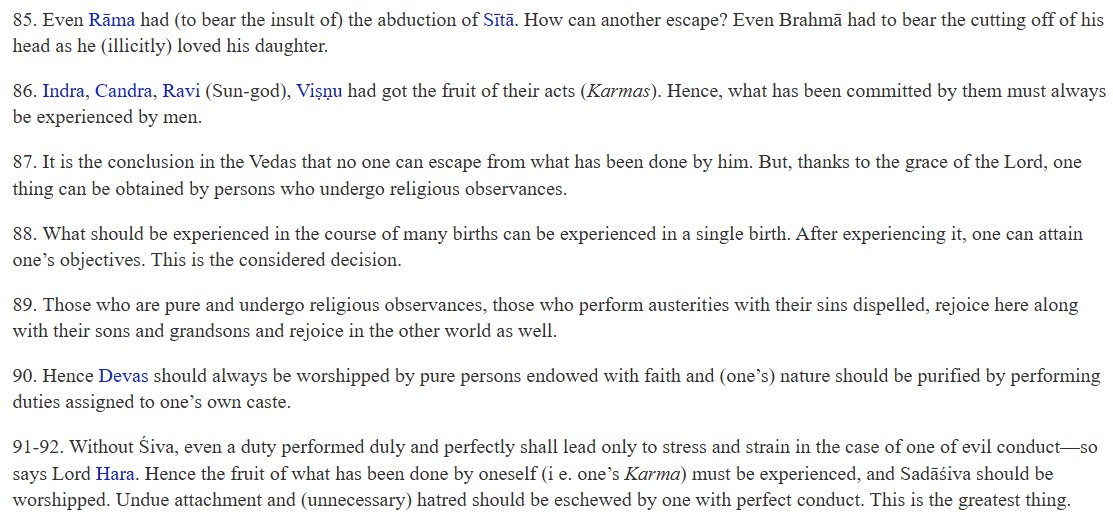The सिद्धान्त-शैव significance of नवरात्री for शैव-s:
From the वामदेव-मन्त्र of the पञ्चब्रह्म-मन्त्र-s (5 वैदिक/आगमिक मन्त्र-s for 5 complete, undivided modes of सदाशिव), the sages of the सिद्धान्त extracted the names of 9 देवी-s:
From the वामदेव-मन्त्र of the पञ्चब्रह्म-मन्त्र-s (5 वैदिक/आगमिक मन्त्र-s for 5 complete, undivided modes of सदाशिव), the sages of the सिद्धान्त extracted the names of 9 देवी-s:
1. वामा
2. ज्येष्ठा
3. रौद्री
4. काली
5. कलविकरणी
6. बलविकरणी
7. बलप्रमथनी
8. सर्वभूतदमनी
9. मनोन्मनी
These are the 9 शक्ति-s who represent the various potencies of सदाशिव (in his mode as वामदेव) in his lordship of the impure universe (अशुद्ध-अध्वा, अशुद्धाध्वा).
2. ज्येष्ठा
3. रौद्री
4. काली
5. कलविकरणी
6. बलविकरणी
7. बलप्रमथनी
8. सर्वभूतदमनी
9. मनोन्मनी
These are the 9 शक्ति-s who represent the various potencies of सदाशिव (in his mode as वामदेव) in his lordship of the impure universe (अशुद्ध-अध्वा, अशुद्धाध्वा).
Where the पौराणिक-शैव or स्मार्त or शाक्त sees the significance in 9 दुर्गा-s, one whose mind is attached to the सिद्धान्त-शास्त्र understands these to be the 9 वामादि-शक्ति-s embedded in the वामदेव-मन्त्र.
1. वामा - She represents the power to create this अशुद्धाध्वा, the impure path (this material universe which ranges from कला-तत्त्व to पृथिवी-तत्त्व) in which various levels of bound souls पशु-s dwell. (सृष्टि)
2. ज्येष्ठा - She represents भगवान् सदाशिव’s power to sustain this bound creation. (स्थिति)
3. रौद्री - She is भगवान्’s power to withdraw the impure creation back into himself at the right time. (संहार)
3. रौद्री - She is भगवान्’s power to withdraw the impure creation back into himself at the right time. (संहार)
4. काली - She, the dark one, is स्वामी’s power to obscure/conceal the vision of the bonded. But this concealment is not to do us ill. In fact, it is another side of the same coin of the function of grace. ++
4. Cont’d: What is called “concealment” is actually भगवान्’s grace for the insentient (जड) bonds पाश-s of मल, कर्म & माया. Wait, what is meant by grace (अनुग्रह) for जड-विषय-s? It means that the insentient objects are able to exercise the properties innate to them.++
4. Cont’d: So, भगवान् graces even the insentient objects by causing them to function the way they are supposed to function. माया is the raw material for our gross/subtle bodies, our instruments of cognition & action, our worlds & all the insentient objects in them.++
4. Cont’d: How is कर्म blessed? It bears the seed for future states that we will undergo & माया is appropriately modified in accordance with our कर्म (we get a good/bad body or come into contact with a good/bad part of this world or good/bad objects, etc).
4. Cont’d: मल, the beginningless impurity that conceals the soul’s ability to fully know & act like शिव. So wait, why does he bless these 3 things which seem to be trouble? The thing is; each of them, in relation to each individual soul, has only a finite grip on that soul.++
4. Cont’d: When he graces these 3, he is allowing them to act & thus expire as fast as possible. When our कर्म & मल gradually mature due to the gradual exhaustion of their potency, we become fit to receive अनुग्रह.++
4. Cont’d: Thus, even the concealment, this veiling of the soul (तिरोभाव) is for our good only.
Thus, काली is that veiling power (तिरोभाव).
To be continued
Thus, काली is that veiling power (तिरोभाव).
To be continued
If you are fortunate enough to be born in the तैत्तिरीय-शाखा or otherwise eligible, learn the वामदेव-मन्त्र (in fact, all पञ्चब्रह्म-s) from a गुरु properly & recite it with devotion. For others, pay a नमस्कार mentally to each of the names of the divine mother.
5. कलविकरणी - The one who causes a stirring/change in the कल-तत्त्व or one devoid of कल.
What is कल/कला तत्त्व? If a sentient entity’s powers of cognition & action are completely obscured by मल, then it is good as insentient. It is effectively जड.++
What is कल/कला तत्त्व? If a sentient entity’s powers of cognition & action are completely obscured by मल, then it is good as insentient. It is effectively जड.++
5. Cont’d: Without cognition (दृक्) & action (क्रिया), how are we going to experience the fruits of our कर्म & exhaust the कर्म-stockpile & find our way out, both of which involves both दृक् & क्रिया.
So, there comes कल. This तत्त्व makes a small “cut” in the मल.++
So, there comes कल. This तत्त्व makes a small “cut” in the मल.++
5. Cont’d: Every आत्मा, that is, every ordinary, fully bonded, sentient entity, every such fully bonded soul, is endowed with this कल (kala). This कल arises out of अशुद्धमाया at each creation. This कल is a blessing because it helps us know & act. But++
5. Cont’d: But it is also a problem. In conjunction with कर्म & माया & all the तत्त्व-s lower than कल in the तत्त्व-hierarchy, कल lulls us into a complacent thinking that our abilities to cognize & act are perfectly in order. But it isn’t.
• • •
Missing some Tweet in this thread? You can try to
force a refresh













